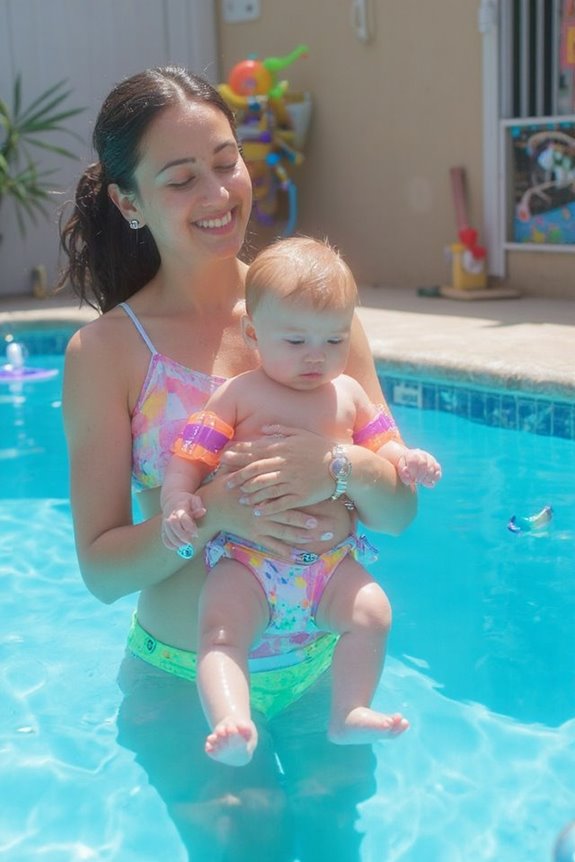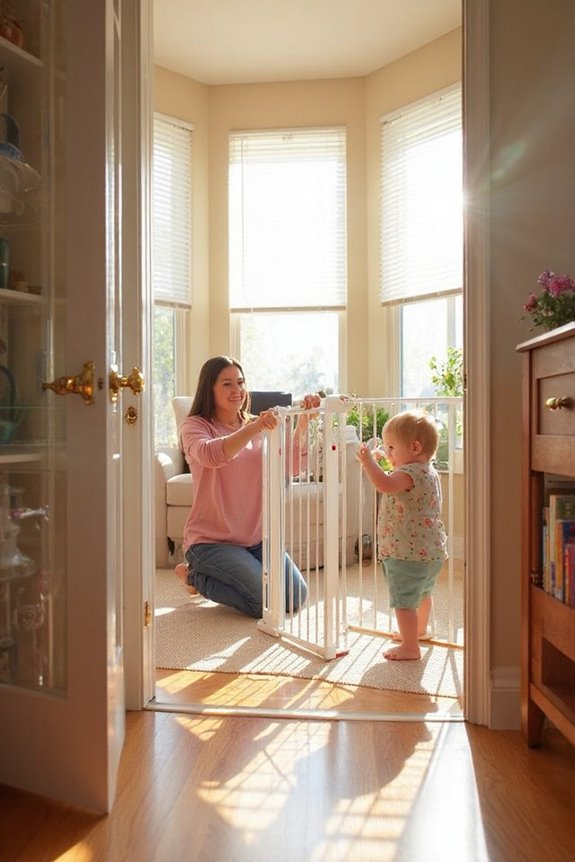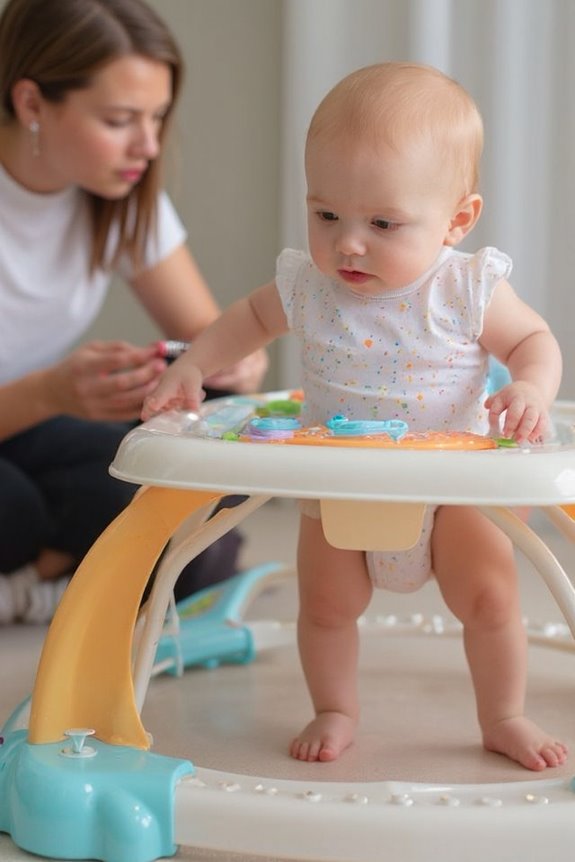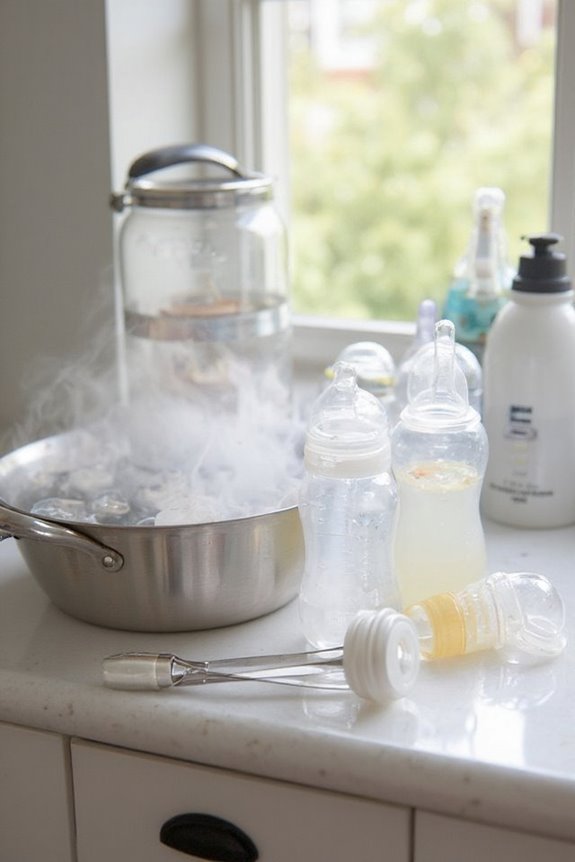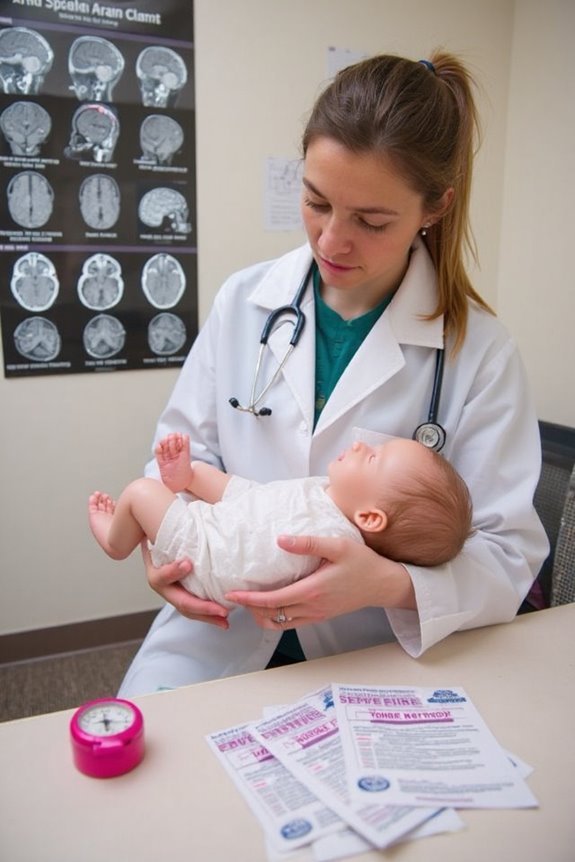Babies can safely experience pool time around 6 months old when they’ve developed good head control and can sit with minimal support. I recommend waiting until this age because younger infants can’t regulate body temperature effectively in pool water. Always maintain constant supervision, use proper safety equipment like infant life jackets, and guarantee water temperature stays between 86-92°F. Keep initial sessions brief (10-15 minutes) and use swim diapers. The sections below offer essential guidance for guaranteeing your baby’s first aquatic experiences remain both enjoyable and safe.
Key Takeaways
- Babies can begin pool activities around 6 months old when they have good head control and can sit with minimal support.
- The American Academy of Pediatrics recommends formal swimming lessons starting at age 1.
- Water temperature should be between 86°F-92°F (30-33°C) for infant comfort and safety.
- Initial swimming sessions should be limited to 10-15 minutes to avoid fatigue and temperature drops.
- Constant supervision within arm’s reach is essential, regardless of a baby’s age or swimming ability.
At What Age Can Babies Start Swimming?
While there’s no single “right age” for all babies to start swimming, most pediatricians recommend waiting until your baby is around 6 months old before introducing them to the pool. By this age, most infants have developed sufficient head control and can sit with minimal support—two critical developmental milestones for safe water exposure.
When considering infant water acclimation, watch for these readiness signs:
- Good head control
- Ability to sit upright with little assistance
- Interest in water
Baby swimming techniques typically begin with simple exposure—letting your little one get comfortable with water sensations. The American Academy of Pediatrics doesn’t specify an exact starting age but suggests formal swimming lessons around age 1, though parent-child water classes are available earlier.
Remember: Regardless of age, constant supervision is non-negotiable.
Essential Pool Safety Measures for Infants
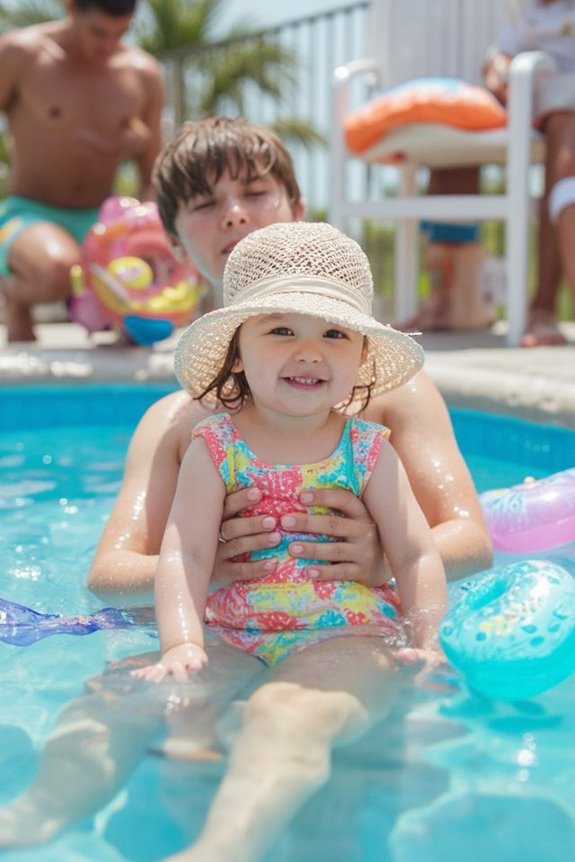
Now that you know when babies can start swimming, let’s focus on keeping them safe in and around pools. Proper infant supervision is the most critical aspect of pool safety—never leave your baby unattended near water, even for a moment.
Ensure your pool has:
- A fence at least 4 feet high with no gaps wider than 4 inches
- Self-closing, self-latching gates
- A fence positioned 3-5 feet from the pool edge
Additional safety measures include:
- Installing alarms on doors leading to the pool
- Using a power safety cover when the pool isn’t in use
- Keeping rescue equipment nearby (shepherd’s crook, life jackets)
- Maintaining a first aid kit and phone for emergencies
Consider taking infant CPR classes—this knowledge could save your baby’s life in an emergency situation.
The Right Water Conditions for Baby’s First Swim
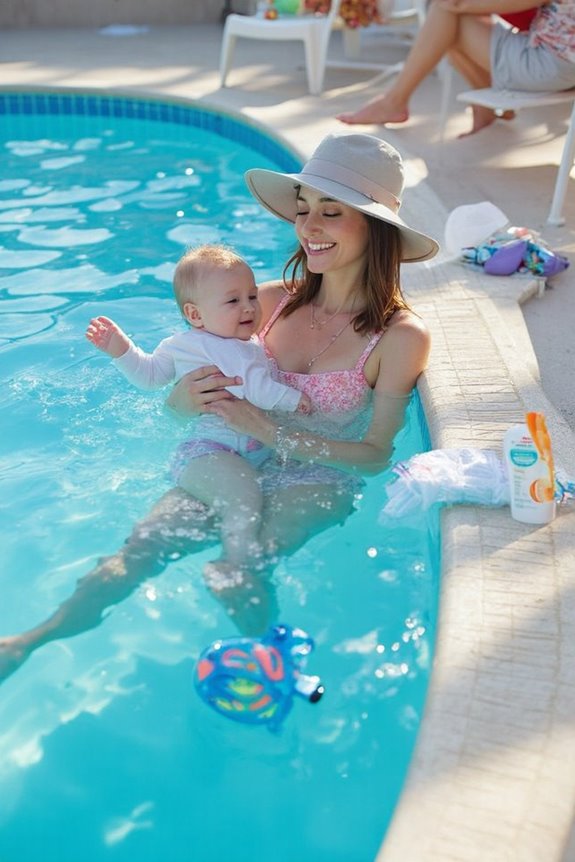
Creating the perfect environment for your baby’s first pool experience involves three essential factors: water temperature, chemical balance, and overall pool cleanliness.
For water temperature, I recommend keeping it between 86°F and 92°F (30-33°C). Babies lose body heat quickly due to their higher skin-to-weight ratio, making proper temperature vital for comfort and safety.
Regarding chemical safety:
- Monitor chlorine levels carefully, as excessive exposure may increase respiratory risks
- Consider that studies suggest more than 20 hours of pool time in infancy might raise asthma risk
- Saltwater pools offer a gentler alternative with lower chlorine levels
Always test water with a thermometer before entering, limit initial sessions to 10-15 minutes, and dry your baby thoroughly afterward to maintain body warmth.
Protective Gear and Equipment for Baby Pool Time
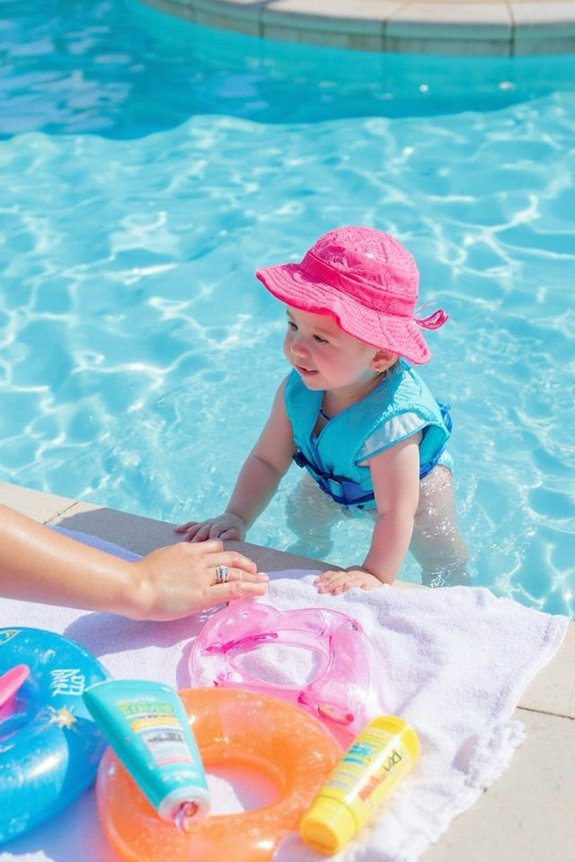
Proper safety equipment forms the foundation of a secure swimming environment for your baby’s pool adventures. When introducing your little one to water, these essentials are non-negotiable:
- U.S. Coast Guard-approved life jackets that fit snugly on your baby
- Baby flotation devices designed specifically for infants (always with your supervision)
- Age-appropriate swimming aids that support your child’s developmental stage
- Proper swim diapers to maintain pool hygiene
- Installing MagnaLatch ALERT or Poolguard Door Alarms on gates
- Setting up mesh pool fencing (minimum 4 feet high)
- Using pool surface alarms to detect unexpected water movement
- Splashing fun: Encourage gentle splashing in shallow water to develop motor skills
- Sensory play: Use colorful floating toys to stimulate visual development
- Water games: Try simple cause-and-effect activities with cups and containers
- Musical engagement: Sing water-themed songs to create a positive atmosphere
- Maintain constant arm’s-reach supervision
- Keep water lukewarm to prevent chilling
- Guarantee water depth remains very shallow
- Place the pool on a flat, soft surface
For pool areas, I recommend:
Remember: Even with the best equipment, nothing replaces “touch supervision” – keeping your baby within arm’s reach at all times.
Fun and Safe Pool Activities for Babies
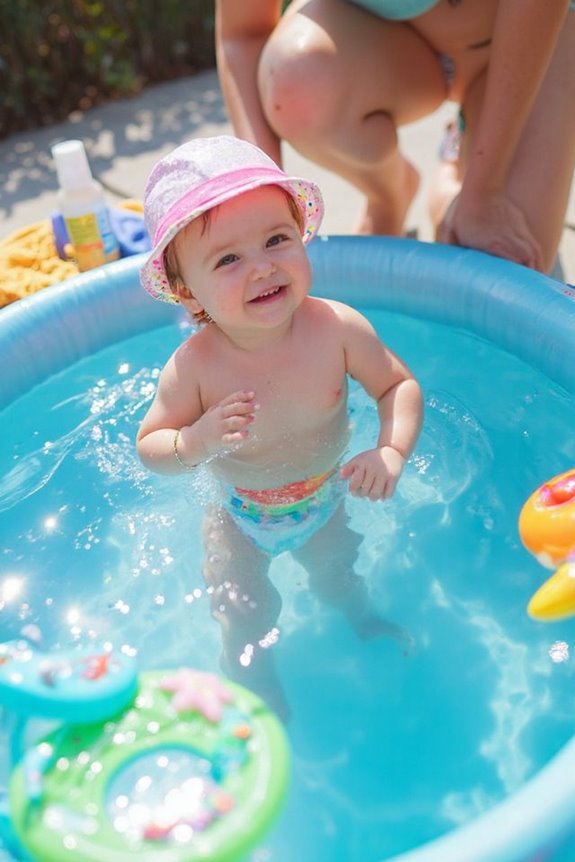
While introducing your baby to water, engaging activities can make pool time both enjoyable and developmentally beneficial. I recommend these age-appropriate options:
Remember these safety essentials:
For babies 6+ months, retrieving floating objects can improve coordination while building water confidence. Always prioritize safety over activity complexity.
Frequently Asked Questions
Can Babies Who’ve Had Ear Infections Go Swimming?
If your baby has had ear infections, I’d recommend waiting until they’re fully healed before swimming. For otitis externa, wait three days after symptoms resolve. Always prioritize ear protection and swimming safety to prevent recurrence.
How Long Should a Baby’s First Pool Session Last?
Like dipping toes in unfamiliar waters, I’d recommend keeping your baby’s first pool experience brief. For baby swim duration, start with just 10-15 minutes and watch for signs they’re getting cold or fussy.
Is Indoor or Outdoor Swimming Better for Babies?
I’d say it depends on your circumstances. Indoor pools offer benefits like temperature control and less UV exposure. Outdoor pools have natural sunlight but come with risks of sun exposure and variable temperatures.
Can Chlorine Cause Diaper Rash in Babies?
Yes, chlorine can cause diaper rash in babies with chlorine sensitivity. I recommend thorough rinsing after swimming and proper diaper care, including applying protective barrier creams and changing diapers promptly to prevent irritation.
Should Babies Eat Before or After Swimming?
I recommend light snacks before swimming to maintain your baby’s energy. Pre-swim hydration is important too! There’s no strict rule, but I’ve found that timing meals around your baby swimming prevents discomfort.

